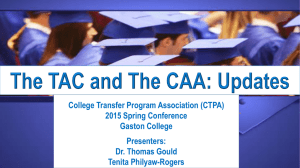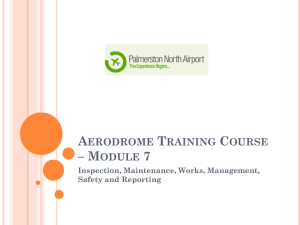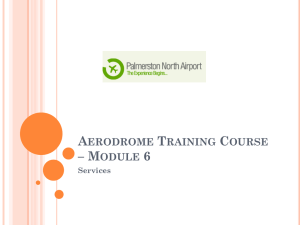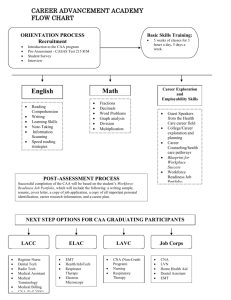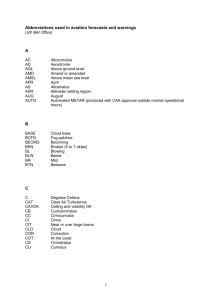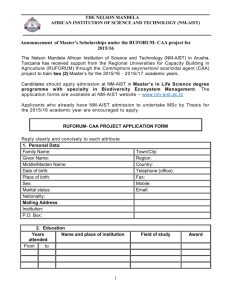Aerodrome Safety Workshop
advertisement
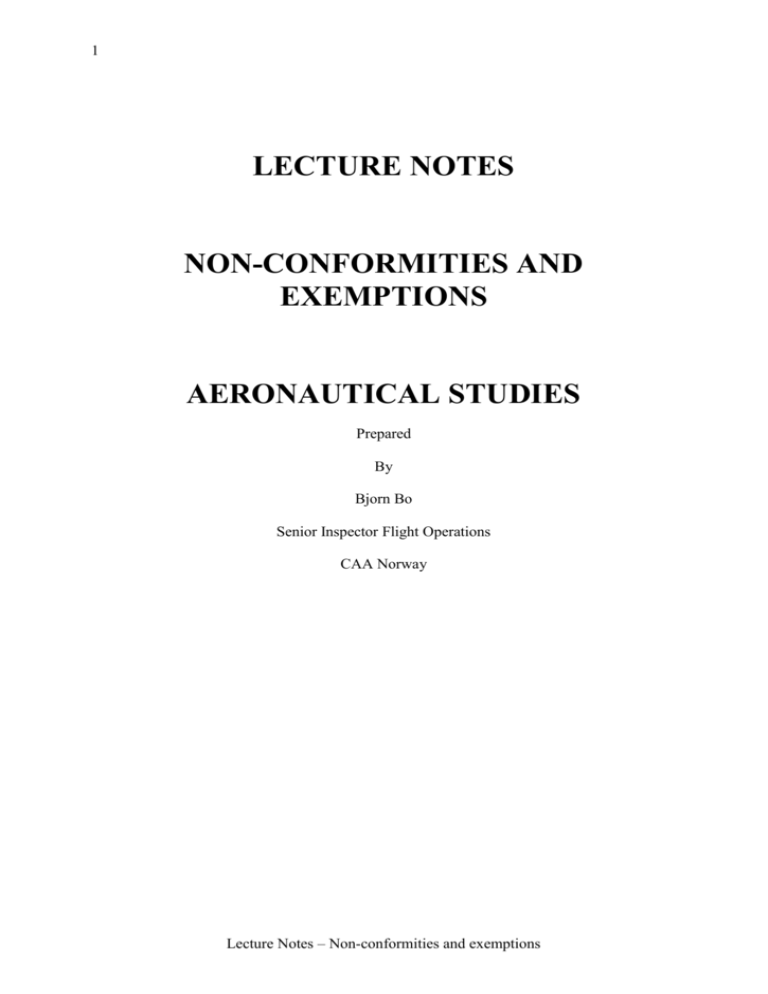
1 LECTURE NOTES NON-CONFORMITIES AND EXEMPTIONS AERONAUTICAL STUDIES Prepared By Bjorn Bo Senior Inspector Flight Operations CAA Norway Lecture Notes – Non-conformities and exemptions 2 NON-CONFORMITIES AND EXEMPTIONS AERONAUTICAL STUDIES TABLE OF CONTENTS 1.0 2.0 3.0 4.0 5.0 6.0 7.0 8.0 INTRODUCTION TYPES OF NON-CONFORMITIES WHAT TO DO? THE ICAO REQUIREMENTS AERONAUTICAL STUDY TECHNICAL ANALYSIS CAA ACTIONS LIMITATIONS 1.0 INTRODUCTION First back to basics. Basic principles of aerodromes certification are simple. One takes a filter, pours the aerodrome through it and finds out what remains in the filter. The filter is the set of design and operational regulations applicable to that specific aerodrome. Ideally nothing remains in the filter, this implying that the aerodrome fulfils all the requirements and a Certificate may be issued. In the real world that seldom happens, particularly when certificating existing aerodromes. However, it may also happen with new ones. Usually you will find that something remains in the filter. These are the non-conformities, i.e. items that do not comply with the regulation. In this session we will look at how these issues can be handled. 2.0 TYPES OF NON-CONFORMITIES In the certification process one will typically uncover two types of non-conformities. There might be non-conformities relative to the operational regulations. Examples: Lack of procedures Insufficient maintenance programs Competency issues Lecture Notes – Non-conformities and exemptions 3 There might be non-conformities relative to the design regulations. Examples: Terrain or objects penetrating the obstacle limitation surfaces Insufficient strip and RESA (Dimensions and/or quality) Insufficient runway/taxiway separation Lack of, or wrongly designed visual aids 3.0 WHAT TO DO? In principle there are three ways to handle non-conformities. Ignore them. Correct them. Accept them on specified conditions. The first option is clearly a non-starter. One of the main benefits of certificating aerodromes is to identify and register non-conformities. Get them out in the open. At least, one can then take precautionary measures. Also, and most important, a process can be established with a view to decide upon which of the two remaining options shall be selected. Corrective action is, in principle the preferred one. Usually non-conformities related to the operational regulation are possible to correct within an acceptable timeframe. This is so because corrective action in this case usually involves establishing or improving procedures and/or competency. This is also usually not very expensive. When it comes to non-conformities related to the design rules, it becomes more difficult. Corrective actions should always be sought, and in some cases corrective action is possible within an acceptable timeframe. Examples are markings, signs and to some extent lights, fencing and so forth. Other non-conformities related to the design regulations can be more difficult to handle. Some examples again: Terrain or objects penetrating the obstacle limitation surfaces Insufficient strip and RESA (Dimensions and/or quality) Insufficient runway/taxiway separation Sometimes it is possible to correct, at least partially, but in reality one often faces these possibilities: It is either physically impossible; or it is economically impossible. As the issuance of a certificate is dependent upon compliance with requirements, one can easily see a problem. Lecture Notes – Non-conformities and exemptions 4 The simple solution is of course to deny a certificate, but then it would be illegal to have the aerodrome open to traffic. In some cases this is not a solution that is easy to back up, particularly if that aerodrome has served its community for many years without accidents or incidents that can be attributable to the aerodrome and its non-conformities. The interesting solution is to look into the Certification Manual. 4.0 THE ICAO REQUIREMENTS First let us look at the good news of Doc 9774. 3E.1.1 The CAA may exempt, in writing, an aerodrome operator from complying with specific provisions of these regulations. 3E.1.2 Before the CAA decides to exempt the aerodrome operator, the CAA must take into account all safety-related aspects. 3E.1.3 An exemption is subject to the aerodrome operator complying with the conditions and procedures specified by the CAA in the aerodrome certificate as being necessary in the interest of safety. We will leave the bad news until the end of the session and try to explain how one can utilise the option we have seen. In essence, this regulation makes it possible to accept non-conformities, provided all safety aspects have been considered and that proper mitigating measures have been put in place. All this must of course be documented. The ICAO term is Aeronautical Study. 5.0 AERONAUTICAL STUDY Doc 9774, Appendix 3. 5.1 DEFINITION An aeronautical study is a study of an aeronautical problem to identify possible solutions and select a solution that is acceptable without degrading safety. Lecture Notes – Non-conformities and exemptions 5 5.2 PURPOSE An aeronautical study is conducted to assess the impact of deviations from the aerodrome standards specified in Volume I to Annex 14 to the Convention on International Civil Aviation, and the national regulations, to present alternative means of ensuring the safety of aircraft operations, to estimate the effectiveness of each alternative and to recommend procedures to compensate for the deviation. 5.3 TECHNICAL ANALYSIS Technical analysis will provide justification for a deviation on the grounds that an equivalent level of safety can be attained by other means. It is generally applicable in situations where the cost of correcting a problem that violates a standard is excessive but where the unsafe effects of the problem can be overcome by some procedural means which offer both practical and reasonable solutions. In conducting a technical analysis, inspectors will draw upon their practical experience and specialized knowledge. They may also consult other specialists in relevant areas. When considering alternative procedures in the deviation approval process, it is essential to bear in mind the safety objective of the aerodrome certification regulations and the applicable standards so that the intent of the regulations is not circumvented. 6.0 TECHNICAL ANALYSIS 6.1 Introduction What ICAO calls the Technical Analysis clearly involves a Risk Analysis. Neither the time nor my competence allow us to go very deep into this matter. Risk Analysis is a profession in itself. However, if aeronautical expertise, both flight operational and aerodrome (and PANS-OPS) are not heavily involved in the process, it will be a waste of effort. We will, however, present some thoughts on the conduct of risk analysis. It is the aerodrome that presumably wants the exemption, and so it should be the aerodrome that should have the risk analysis performed. However, it would be sensible to have a dialogue with the CAA about the ways and means. A Risk Analysis should contain the following elements: A description of problems and objectives Selection of procedures, methods and data sources Identification of undesired events An analysis of causal factors and consequences A description of risk Mitigating measures Presentation of results Lecture Notes – Non-conformities and exemptions 6 6.2 A description of problems and objectives The first step of any risk analysis is to define the problem and the objective of the exercise, and to assign someone to carry it out. The problem can be to find out the safety implications of not complying (in full) with a certain regulation or regulations. The objective should include an assessment of how certain mitigating measures influence these safety implications. Then someone, should involve aerodrome and flight operational expertise and preferably someone with experience in the field of risk analysis, in other words, a working group is necessary. 6.3 Procedures, methods and data sources. A main issue is whether it shall be a quantitative or qualitative approach. The answer will to a large extent depend upon the data-sources available. A qualitative approach, based on common sense and qualified expert opinion will probably, in many cases, yield results that are far better than nothing, and better than a quantitative approach based on a limited set of unreliable data. Even if it is possible to carry out a quantitative approach, qualified expert opinion is necessary, particularly in the next step. 6.4 Identification of undesired events Next, identify the undesired events (hazards) attributable to the nonconformity. An undesired event is clearly a total loss of aircraft with lives. Another is major damage to aircraft and/or personnel. Possibly minor damage to aircraft and/or personnel. 6.5 An analysis of causal factors and consequences The basic questions are: What can go wrong, where and why? How likely is it that it goes wrong? What can go wrong? Collision with terrain, aircraft, vehicle, object? Aircraft landing pre-threshold, overrunning or veering off the runway? Lecture Notes – Non-conformities and exemptions 7 Where can it go wrong? During flight (approach, landing, balked landing, take-off, climb-out) On Ground Why can it go wrong? Causal factors can comprise, but are clearly not limited to: Lack of guidance (lights, markings, signs) Confusing guidance Insufficient protected area In some cases these factors can contribute to the accident happening. In other cases they can increase the consequences of an incident so that it becomes an accident. How likely is it that it goes wrong? Probability, if one has available relevant data to make a quantitative assessment, is fine. If not, a qualitative assessment based on expert opinion will have to do. What are the (potential) consequences if it goes wrong? Catastrophic? The loss of the aircraft Multiple fatalities Hazardous? A large reduction in safety margins Physical distress or a workload such that the flight crew cannot be relied upon to perform their tasks accurately or completely Serious injury or death of a relatively small proportion of the occupants Major? A significant reduction in safety margins A reduction in the ability of the flight crew to cope with adverse conditions as a result of increase in workload or as a result of conditions impairing their efficiency Injury to occupants Minor? Nuisance Operating limitations: emergency procedures 6.6 A description of risk Having identified the factors listed above it is possible to calculate or describe the risk (probability times consequences) associated with a non-conformity. The next step on the agenda is to identify and put in place mitigating measures so as to manage the risk to As Low As Reasonably Practical (ALARP). Lecture Notes – Non-conformities and exemptions 8 6.7 Mitigating measures Mitigating measures should aim at one or both of the following: Reduce the probability of an undesired event happening. Reduce the consequences of an undesired event. When contemplating mitigating measures, it is always necessary to look to the intent of the regulation which is not (fully) complied with. Examples of mitigating measures. Publication in the AIP is a minimum, also Annex 15 Standard. This is necessary in order that the airlines can take their precautions as they are obliged to do according to Annex 6. Procedures are in some cases relevant. Operational restrictions might be necessary. These may include restrictions on all-weather operations, increased spacing between aircraft (in the air or on the ground), operations restricted to operators/crew who can demonstrate special competence. Mitigating measures usually means reduced usability for an aerodrome. Safety and Usability is a balancing act! The mitigating measures should be fed back into the consideration listed in the previous chapter in order to evaluate their relevance and effectiveness in reducing risk Thus the final description should recommend mitigating actions and list the consequences and their probabilities when these are taken into account. 7.8 Presentation of results The work shall be documented in such a way that it is possible to see what has been done. What essential assumptions, presuppositions and simplifications have been made? Any uncertainty about the results due to the choice of and availability of methods, procedures and data sources should be discussed. The results of the risk analysis should emphasise which undesired event contribute the most to risk, and factors influencing these undesired events. Recommendations for measures to mitigate risk (and their estimated effect) shall be stated Lecture Notes – Non-conformities and exemptions 9 7.0 CAA ACTIONS Based on the application made by the aerodrome for an exemption and supported by the result of the Aeronautical study, the CAA may grant an exemption and specify on which conditions the exemption is given. Such conditions, mitigating measures, time limitations etc, shall be approved by the CAA and stated in the aerodrome certificate, ref Doc 9774. 3E.1.3 An exemption is subject to the aerodrome operator complying with the conditions and procedures specified by the CAA in the aerodrome certificate as being necessary in the interest of safety. 8.0 LIMITATIONS Finally, I said we would leave the bad news until the end. Doc 9774 sets some severe limitations on the use of the described procedure. 3E.1.4 When an aerodrome does not meet the requirement of a standard or practice specified in regulation 3A.3, the CAA may determine, after carrying out aeronautical studies, only if and where permitted by the standards and practices, the conditions and procedures that are necessary to ensure a level of safety equivalent to that established by the relevant standard or practice. 9.0 QUESTIONS END Lecture Notes – Non-conformities and exemptions

